If you love Vietnamese coffee, you know that the vietnamese coffee grind size can make or break your cup. Too fine, and the coffee becomes bitter; too coarse, and it tastes weak and watery. In this guide, we’ll show you the ideal grind size for Vietnamese coffee and how to get the best flavor every time.
Overview of Coffee Grind Size
Before you can choose the best grind for Vietnamese coffee, it’s important to understand what “grind size” actually means. In simple terms, coffee grind size refers to how fine or coarse the coffee beans are ground.
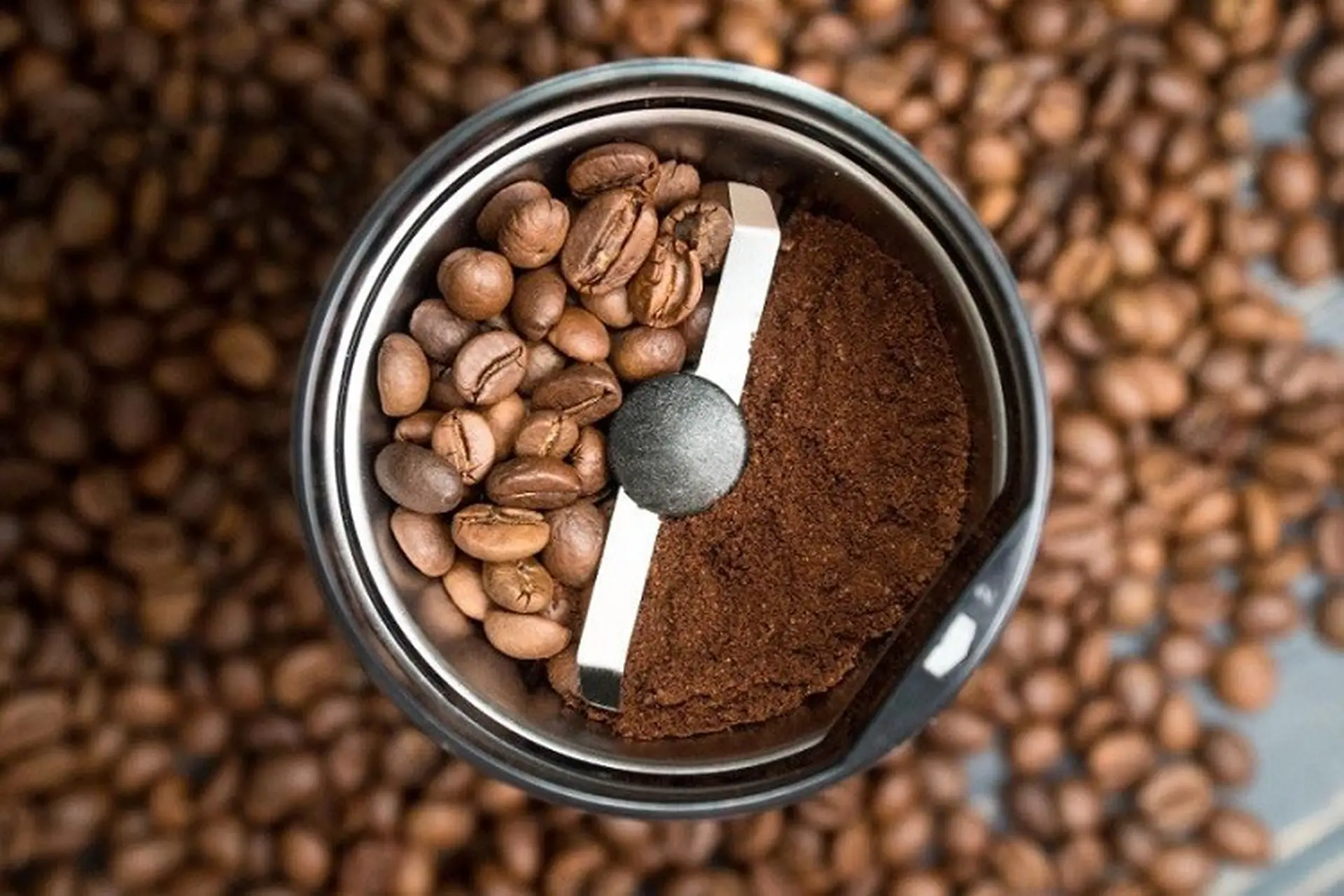
This seemingly small detail plays a huge role in how your coffee tastes, because it directly affects how water flows through the grounds and how quickly it extracts flavor from the beans.
When the coffee is ground very fine, like powder, it has a much larger surface area. That means water extracts the flavors faster, resulting in a stronger, more intense, and sometimes bitter cup if brewed too long. On the other hand, coarser grounds allow water to flow more freely, leading to a lighter, cleaner, and more delicate flavor.
In short, grind size determines how the brewing process “pulls out” the aroma, sweetness, and body of your coffee. And here’s the golden rule that every barista knows:
“There’s no such thing as the best grind — only the grind that fits your brewing method.”
Different brewing methods (espresso, pour-over, French press, or the traditional Vietnamese phin,…) all require different drip coffee grind sizes to balance flavor, extraction time, and mouthfeel.
Why Coffee Grind Size Matters for Vietnamese Coffee?
Many factors determine a perfect cup of delicious coffee. Among them, the vietnamese coffee grind level and corresponding brewing method are extremely important factors that we sometimes overlook.
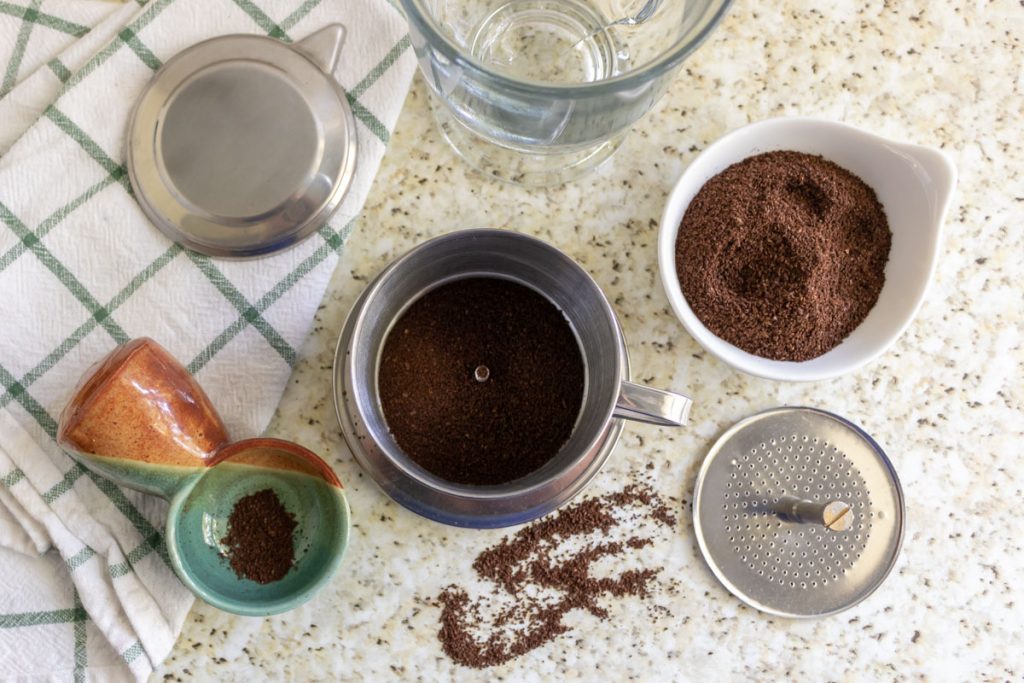
Even when you buy the best coffee beans. You execute the brewing technique correctly, applying the ideal water-to-coffee ratio. And even the perfect temperature. But if you grind the coffee to a size that doesn’t match your brewing device. Sorry to say, you’ve already lost a good cup of coffee.
When brewing Vietnamese phin coffee, grind size is very important. Because the phin works by letting hot water slowly drip through the coffee grounds, and the speed of that drip depends on how fine or coarse your vietnamese coffee grind is.
If the coffee is too fine, the small holes in the phin get clogged. Water can’t pass through easily, and the coffee drips too slowly or even stops. This makes the coffee too strong and bitter.
If the coffee is too coarse, the water runs through too quickly. The coffee doesn’t have enough time to release its flavor, so your cup will taste weak and watery.
What Grind Size is Best for the Vietnamese Coffee Phin?
The best grind size for Vietnamese coffee is Medium to Medium-Coarse.
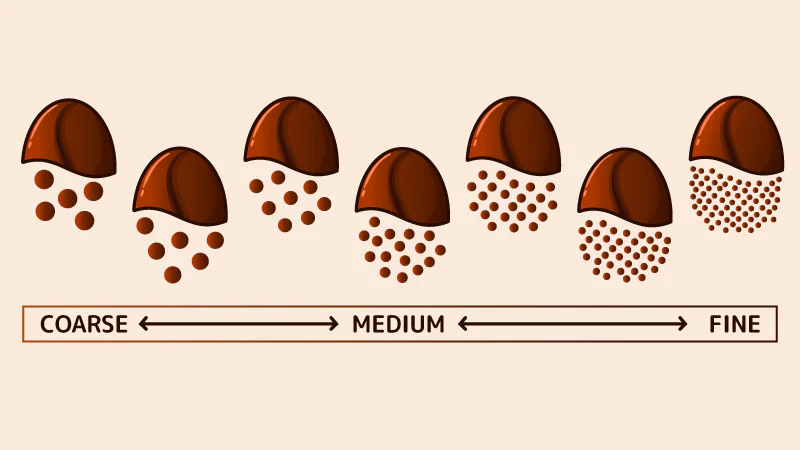
This means the vietnamese coffee grind should look and feel like coarse sand or sea salt, not too fine like espresso powder, and not too chunky like what you’d use for a French press.
This vietnamese coffee grind size lets the water drip slowly through the metal phin filter, usually taking about 4–5 minutes for a full cup. That timing is perfect for bringing out the bold, rich flavors that make Vietnamese coffee unique.
If your coffee drips too slowly, it probably means the grind is too fine. Try adjusting your grinder to make the particles a little larger.
If it drips too quickly, the grind is too coarse, so tighten the grind a bit to slow down the flow.
When you find the right grind for Vietnamese coffee, your Vietnamese phin coffee will have that perfect balance: strong but smooth, bold yet not bitter, and full of aroma.
Read more: How to Roast Coffee at Home Deliciously and Properly
What’s the Grind Size for Different Brewing Methods?
Not only Vietnamese coffee, but coffee grind size is also very important in other brewing methods. The following chart goes over what drip coffee grind size is needed for different methods (when making standard coffee):
| Grind Size | Texture | Best For | Brew Time |
|---|---|---|---|
| Extra Fine | Like flour or powder | Turkish Coffee | 1–2 min |
| Fine | Like table salt | Espresso, Moka Pot | 1–3 min |
| Medium-Fine | Between salt and sand | Pour Over, AeroPress | 2–4 min |
| Medium | Like regular sand | Drip Coffee Maker | 3–5 min |
| Medium-Coarse | Like coarse sand or sea salt | Vietnamese Phin, Chemex | 4–5 min |
| Coarse | Like rock salt | French Press | 5–8 min |
| Extra Coarse | Like peppercorns | Cold Brew | 12–24 hrs |
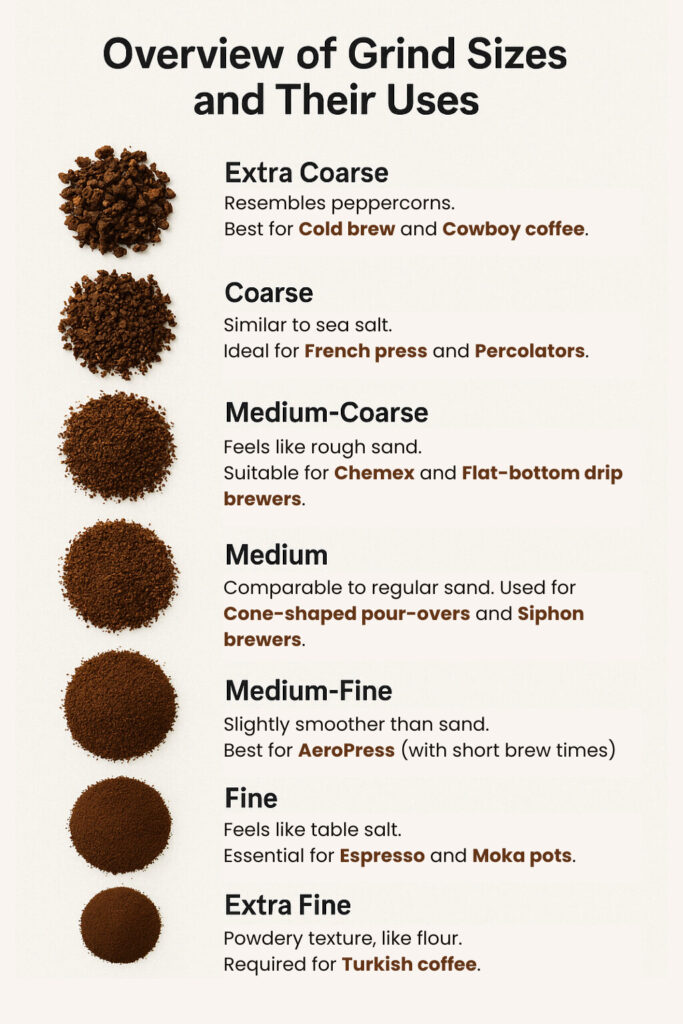
How to Grind Coffee Properly for Vietnamese Phin Coffee
Here’s a step-by-step guide you can follow:
1) Choose the Right Grinder
- Use a burr grinder rather than a blade grinder. Burr grinders produce uniform-sized particles, which are essential for even extraction.
- Blade grinders chop beans unevenly, leading to some grounds over-extracted (bitter) and others under-extracted (sour).
2) Set the Grind Size
- For a traditional Vietnamese phin, the ideal vietnamese coffee grind is medium-coarse, similar to coarse sand or fine sea salt.
- Avoid very fine grind like espresso; it will clog the phin and slow the drip excessively.
3) Measure Your Coffee
- For a standard 1-cup phin, use about 20 grams (around 3–4 tablespoons) of ground coffee.
- Place the coffee in the phin and gently shake to level it, creating an even surface.
4) Assemble the Phin Properly
- Place the pressing filter (the small metal disk) on top of the coffee and press lightly — enough to hold the grounds down, but not too hard. Overly compressed coffee slows the drip too much.
5) Add Hot Water
- Use water heated to 92–96°C (just below boiling).
- Pour about 15–20 ml of water first to bloom the coffee for 20–30 seconds, allowing the coffee to expand.
- Then fill the rest of the phin with water, around 100–120 ml depending on cup size.
6) Check the Drip Time
- A properly ground medium-coarse vietnamese coffee grind should drip 4–5 minutes for a full cup.
- If dripping too fast, your grind size is too coarse. Adjust slightly finer next time.
- If dripping too slow or stops, grind a little coarser.
7) Grind Just Before Brewing
- Coffee begins losing aroma soon after grinding. Always grind fresh for the best flavor.
Read now: Vietnamese iced coffee with condensed milk recipe
A Few Tips to Make Your Vietnamese Coffee Taste Better
- Use water at 92–96°C: Water that’s just below boiling ensures smooth extraction without burning the coffee, keeping the flavor naturally sweet.
- Adjust coffee-to-water ratio: Around 20 g of coffee for 100–120 ml of water is standard, but you can tweak slightly for a stronger or lighter cup.
- Press the coffee lightly: Gently pressing the grounds in the phin allows water to drip at the right speed; too much pressure makes it slow and bitter.
- Bloom the coffee first: Pour a small amount of water and wait 20–30 seconds to let the coffee expand and release more aroma before adding the rest.
- Grind beans fresh: Coffee loses aroma quickly once ground, so grinding right before brewing keeps your cup flavorful and aromatic.
- Add condensed milk or sugar to taste: Traditional Vietnamese coffee is often sweet and creamy; adjust the amount to suit your preference.
- Clean the phin regularly: Residue and oils from previous brews can affect flavor, so rinse thoroughly after each use for a fresh taste.
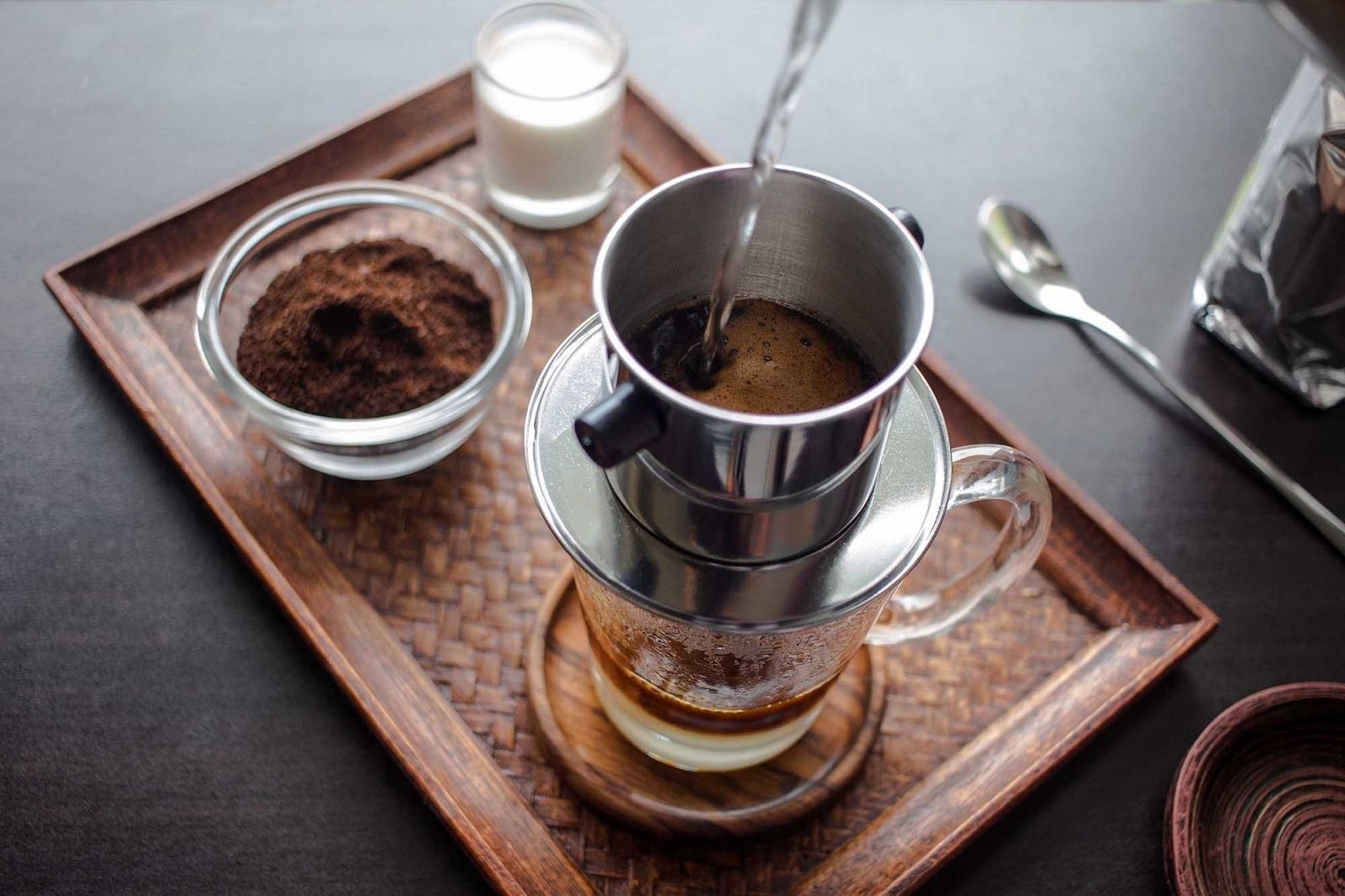
FAQs About Coffee Grind Size
Why Shouldn’t You Buy Pre-Ground Coffee?
Because of convenience and not everyone has a coffee grinder at home, many people often buy pre-ground coffee. If you’re not too particular about demanding a perfectly delicious, authentic cup of coffee, that’s fine. But if you expect a perfect cup of coffee, the advice is to only grind coffee beans before brewing for many reasons:
- First, grinding coffee right before brewing ensures its freshness. Because coffee beans are an organic product, their flavor is easily affected by external factors. Coffee is a plant product, not like synthetically manufactured goods. Therefore, it cannot maintain consistent flavor and quality over a long period.
- Second, when coffee is ground, CO2 gas is released, which helps release oils. This creates the distinctive aroma and enhances flavor. Floral and fruity notes mainly come from this process. So if you use pre-ground coffee, it’s difficult to experience that wonderful quality.
- Third, when grinding, oxygen penetrates the coffee powder being ground. The cells inside will be broken down and make it have a vivid smell and taste. Without it, the coffee will be cloudy, dull in color, and have a slight soapy smell.
Therefore, if you don’t grind coffee before brewing but use coffee that was ground long ago, you risk losing the wonderful qualities of coffee. Imagine coffee flavor is like the flavor in ripe fruit. It will burst with aroma, crisp acidity, and refreshing sweetness when tasted right after cutting.
How Long Can Roasted and Ground Coffee Be Stored?
Roasted whole bean coffee retains its aroma longer than ground coffee because it has less surface area exposed to air. If stored in a sealed bag, away from light and moisture, whole bean coffee can maintain good flavor for about 2–4 weeks from the roasting date. You can also store it in the refrigerator or freezer if you need long-term storage, but you need to bring the coffee to room temperature before grinding to avoid water condensation.
Ground coffee is more sensitive and loses aroma faster due to its larger surface area exposed to air. If kept in an airtight container, away from light and moisture, ground coffee should be used within 3–7 days, maximum 2 weeks. Therefore, for a fragrant and delicious cup of coffee, it’s best to grind right before brewing and only buy enough for 1–2 weeks of use.
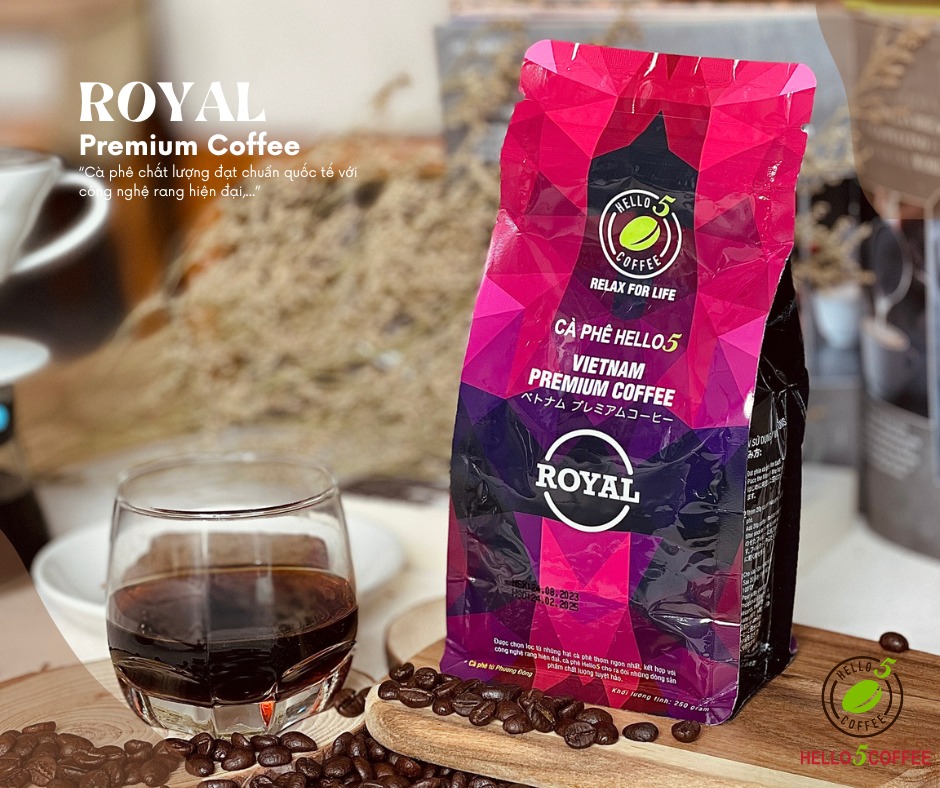
In conclusion, this article has guided you on choosing the right vietnamese coffee grind size and shared tips for brewing a rich, flavorful cup with the perfect grind for Vietnamese coffee. We hope this knowledge helps you enjoy the full taste of Vietnamese coffee at home with the ideal drip coffee grind size. Wishing you many enjoyable and aromatic coffee moments. If you are looking for high-quality, freshly roasted beans or pre-ground coffee, be sure to check out Hello 5 Coffee – bringing you the perfect Vietnamese coffee experience every time.
